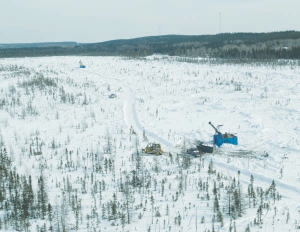Aurizon Mines (ARZ-T, AZK-X), a gold producer in the Abitibi region of northwestern Quebec, has extended, through infill drilling, the promising Hosco zone at its Joanna project, 20 km outside of the town of Rouyn-Noranda.
Results from 28 new holes in the Hosco zone totaling 4,403 metres are now in, and further results are pending for 53 holes drilled in the western and eastern extensions of the zone. Currently, both the eastern and western extensions of the planned pit contour are being tested down to a depth of 100 metres.
Of the 28 holes, 11 returned at least one interval above 1 gram gold per tonne over 15 metres (true thickness), including three holes with intervals above 1.5 grams gold over 25 metres (true thickness).
In the western extension, the highlights included hole 10-522 with 1.7 grams gold over 47.4 metres (true width) and hole10-525 with 3 grams gold over 28.9 metres (true width). The two holes are 875 metres west of the actual pit limit and 50 metres below surface.
In the eastern extension, the best result was encountered 25 metres below the surface and 200 metres from the pit limit in hole 09-499, which returned 2 grams gold over 16 metres. A high-grade interval of 33.2 grams gold over 1 metre was reported earlier this year farther down the same hole.
In the western extension, all holes intersected mineralization south of the Cadillac fault (or the South zone mineralization). The South zone is a continuous structure over 900 metres along strike with thickness between 5 and 50 metres. Mineralization north of the fault (North zone) has also been intersected. The North zone has been followed over 400 metres along strike, with thicknesses varying between 10 and 35 metres. Mineralization is open down dip and along strike.
On the eastern extension, mineralization has been intersected 100 metres east of the proposed Hosco pit along 150 metres of strike extension. There are three parallel zones, each roughly 50 metres apart, with thicknesses varying between 5 and 25 metres. The zones are open to the east and down dip.
In the Hosco zone, the mineralization is within two lenses on both sides of the Cadillac break, both dipping 55 degrees to the north. The South zone extends for more than 1,100 metres along the entire length of the deposit. The North zone is restricted to an extension of 500 metres.
A cutoff grade of 0.5 gram gold over a minimum of 5 metres was used to estimate the mineral resource for the Hosco prefeasibility. The study established diluted mineral reserves of 23.6 million tonnes grading 1.3 grams gold for 995,600 oz. gold.
The prefeasibility study also concluded that an initial open-pit could produce about 110,000 oz. gold annually over an initial eight-year mine life.
The prefeasibility related solely to the reserves on the Hosco deposit, and did not take into account any of the resources contained in the Heva deposit, which forms a significant part of the Joanna project. The study also didn’t take into account synergies that Aurizon could obtain from using the milling facilities and infrastructure at its nearby Casa Berardi gold mine. All of this will be addressed in a final feasibility that is expected to be released by the fourth quarter of this year.
Aurizon’s Joanna project has a measured and indicated resource of 11.9 million tonnes grading 1.5 grams gold for 569,000 oz. gold and an inferred resource of 30.9 million tonnes at 1.4 grams gold for 1.35 million oz.
Shares of Aurizon closed up 27¢ or 5.3% on the news to $5.33 per share.
The Vancouver-based company has a 52-week trading range of $3.63- $5.87 and 159.1 million shares outstanding.


Be the first to comment on "Aurizon extends Hosco zone at Joanna"